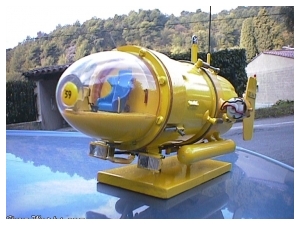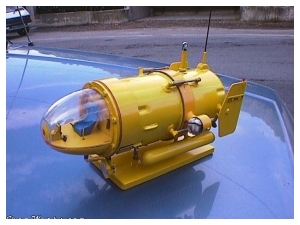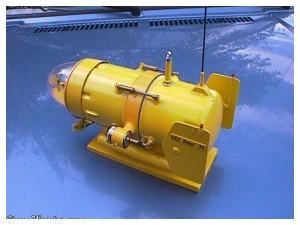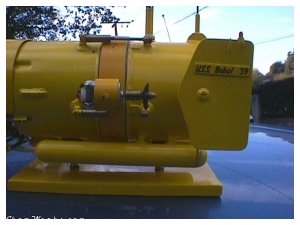Posted on 23/09/2006 at 01:20
Presentation
I've started building this model in 1994, 13 years ago! It has navigated a lot, in the Sciences University ponds, in R/C meetings, in swimming pools, in rivers... And it still does!
The beast is 25cm long. The two half-hulls were made from camping-gaz cans.
The front transparent bulb has been hacked out of a Kinder Rabbit (you know, the one stuffed with little chocolate eggs for Easter!)
The interior of this bulb has been decorated with some die-cast plastic hacked stuff : bucket seat from a BMW, Alouette II helicopter dashboard, stickers from Mirage...
For the static dive, it uses a ballast : it's a small plastic accordion-shaped part (just like the ones on kids bikes, acting as a horn!) on which a servo pushes. It can suck up to 8 grams of water from outside, making the submarine heavier... And it goes up, or down, depending on its relative weight...
Benefits: way easier to build on such a small scale model. Without specific tools (lathe and mill), there's no way to make them water-tight.
Drawbacks : they wear faster, and I've got to change them every year. 4 welds and 7 euros later, and here we go again!
To rotate the submarine, I reverse one motor, so the machine turns like a tank!
The (functional) headlights were hacked from disposable cameras flashes...
The little tube linking the bulb to the hull allows pressuring the bulb ("better bubbles out than water in", this is the rule!). Indeed, all the water-tight elements are put under slight pressure by blowing into the bike tire valve (the little chromed thing on top in front of the antenna)... The LEDs on the fins are functional as well, they flash when the radio is turned on.
And to turn it on, you can see right behind the bulb, on the front half-hull, an 'excrescence', which contains an ILS lamp (there's another one on the other side of the hull).
So, to switch it on, I just have to approach a magnet on the right side, and to switch off, I approach the magnet on the left side.
Such a system is a must-have, in order not to have to disassemble the whole thing to switch the radio on/off...
The fins are made out of epoxy (the one used for PCBs). I perchlorate-engraved them on their inner face to connect the LEDs...
The skates are made out of plumbing copper tubes. The end spheres at the end were made out of bondo (Synthofer, free ad!), molded in a plaster mold (this later made using a marble... Never throw away your child toys!). The rear half-sphere can be removed, by unscrewing it, thanks to a rubber seal.
The beast is 25cm long. The two half-hulls were made from camping-gaz cans.
The front transparent bulb has been hacked out of a Kinder Rabbit (you know, the one stuffed with little chocolate eggs for Easter!)
The interior of this bulb has been decorated with some die-cast plastic hacked stuff : bucket seat from a BMW, Alouette II helicopter dashboard, stickers from Mirage...
Diving :
My model dives both statically and dynamically.For the static dive, it uses a ballast : it's a small plastic accordion-shaped part (just like the ones on kids bikes, acting as a horn!) on which a servo pushes. It can suck up to 8 grams of water from outside, making the submarine heavier... And it goes up, or down, depending on its relative weight...
Motors :
As you can see on the following pictures, the motors run freely in water!Benefits: way easier to build on such a small scale model. Without specific tools (lathe and mill), there's no way to make them water-tight.
Drawbacks : they wear faster, and I've got to change them every year. 4 welds and 7 euros later, and here we go again!
To rotate the submarine, I reverse one motor, so the machine turns like a tank!
The (functional) headlights were hacked from disposable cameras flashes...
The little tube linking the bulb to the hull allows pressuring the bulb ("better bubbles out than water in", this is the rule!). Indeed, all the water-tight elements are put under slight pressure by blowing into the bike tire valve (the little chromed thing on top in front of the antenna)... The LEDs on the fins are functional as well, they flash when the radio is turned on.
And to turn it on, you can see right behind the bulb, on the front half-hull, an 'excrescence', which contains an ILS lamp (there's another one on the other side of the hull).
So, to switch it on, I just have to approach a magnet on the right side, and to switch off, I approach the magnet on the left side.
Such a system is a must-have, in order not to have to disassemble the whole thing to switch the radio on/off...
The fins are made out of epoxy (the one used for PCBs). I perchlorate-engraved them on their inner face to connect the LEDs...
The skates are made out of plumbing copper tubes. The end spheres at the end were made out of bondo (Synthofer, free ad!), molded in a plaster mold (this later made using a marble... Never throw away your child toys!). The rear half-sphere can be removed, by unscrewing it, thanks to a rubber seal.
1






